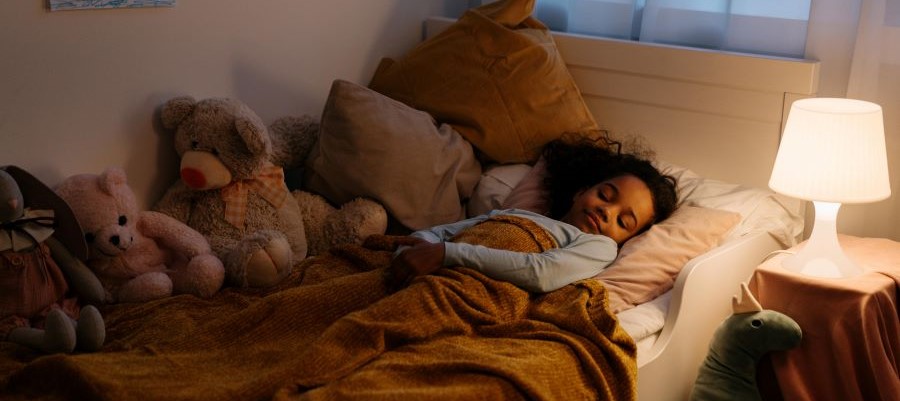Daylight Savings Time Tips for Parents
The switch from Daylight Savings Time to Standard Time and vice versa can take its toll on a family’s energy level. While springing an hour forward or back may not be a big deal for most adults, it can really upset a child’s sleep pattern, which results in tired parents.
Luckily, there are ways to ensure springing back and forth goes smoothly. Much of the advice given here centers on principles that works for adults too: Stability, avoid excessive stimuli, and make time for rest during the day.
On Children and Sleep
Healthy sleep patterns for children start with proper routines. Young children should have consistent nap and bedtimes. Older children should have regular bedtimes and morning wake times, weekends included.
Of course, juggling bedtime routines for a young child in real life – or multiple bedtimes – does not always happen as we would like them to. However, striving to stick with a healthy sleep routine can make a world of difference.

In addition to a consistent bedtime routine, here are some healthy sleep habits to consider for everyone in your family:
Avoid blue light at bedtime
Blue light is emitted from electrical lights and from electronic devices. Our bodies respond to blue light by producing Cortisol, the hormone connected to day-time activities and vigilance. For this reason, it is important to avoid blue light at bedtime. Especially, avoid handheld electronics, such as smartphones and tablets, 1 to 2 hours prior to bedtime. If this is not possible, try to dim the brightness of your screen as much as possible. Many mobile devices and tablets have a ‘blue light filter’ setting that can help reduce the amount of blue light emitted from the device.
Turn down the heat
During sleep our body automatically lowers its temperature. You can help your body get into the sleeping state by keeping the heaters turned low and ensuring proper ventilation. A bedroom temperature of around 20º Celsius (68º F) should be comfortable for most people.
Don’t eat before bedtime
Snacks (especially sugary ones) right before bedtime are not conducive to sleep. In your sleep the body shuts down most of its systems, so if you stimulate your digestion through food, chances are you will have a harder time falling asleep.
Keep the bedroom quiet and comfortable
Make sure that your bedroom has drawable curtains to block outside lights and try to eliminate any distracting noises as much as possible. Consider the radiance of your alarm clock – and how close it is to your bedside. It may help to remove bright alarm clocks or turn them away so you do not see the numbers.
Lower the pace in the evening
Avoid physically demanding games or exercise right before bedtime. When the body is physically stimulated, it produces hormones like epinephrine and adrenaline, which can make it difficult to fall asleep. Reserve the late evening for more quiet activities such as reading or drawing.
How to Prepare your Child for DST
Now for some more specific advice on how to successfully adjust your family to Daylight Savings Time. Remember that there is no one-size-fits all, and that some of the tips below might not make sense for exactly your family or circumstances.

Gradual adjustment
For four days prior to daylight savings time, try to put your child(ren) to bed 15 minutes earlier than usual each day. Work gradually towards achieving an earlier bedtime each day, by 15 minutes on the first day, 30 minutes on the second, 45 minutes on the third, and finally a full hour on the day of daylight savings time. In this way, your child(ren) will transition more smoothly to Daylight Savings Time, and the time difference will be easier. When setting the clocks back, simply do the reverse, going to bed a little later each day.
How to Explain Daylight Savings Time to a Child
Depending on the age of your child, you might also make things easier for them by explaining the very concept of daylight savings time:
- Explain the seasons, and the difference in light-hours
- Explain not just the process of daylight savings time, but also the benefits: We will have more time to play outside, it makes it easier to find your way.
- Use a clock, and other props helpful for your explanation (fx. Pen and paper, globe)
- Create perspective by mentioning that in some countries they don’t have Daylight Savings Time.
Admittedly, to explain Daylight Savings Time can be difficult, but if you can make your child understand it as something positive and meaningful, you’ve gained a lot already.
Naps are for children too!
It’s not just adults who benefits from a power nap. In fact, studies have shown that pre-schoolers who nap score higher on visuospatial memory tasks. For school-age children too, napping has been significantly associated with better academic achievement, higher happiness and increased self-control.
Part of the explanation why napping supports learning is that when we sleep, our experiences are consolidated with earlier memory, and thus transferred from short-term to long-term memory.
Overall, having a regular afternoon rest time – for the whole family – is beneficial. Even if you or your child(ren) do not fall asleep, taking a break from the bustle of the day can lower anxiety, blood pressure, allow for people of all ages to reset and refresh to take on the rest of the day with renewed energy. However, it should be noted that napping and daytime sleep serves remarkably different functions for children of different age groups and for adults.
Is DST over soon?
In the recent years, there have been some talk about abolishing DST in favor for a single, year round standard time. As of 2025, this still hasn’t happened, and a change seems to have long perspectives in both the US and Europe. Read more about this here.


